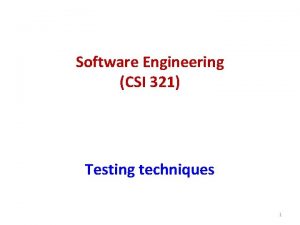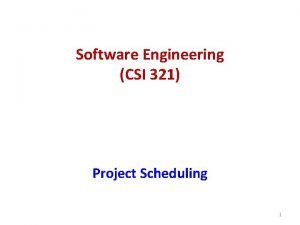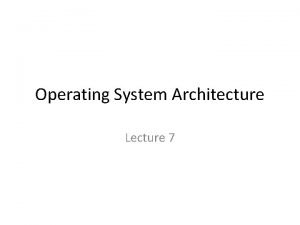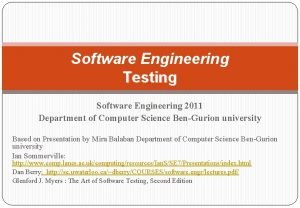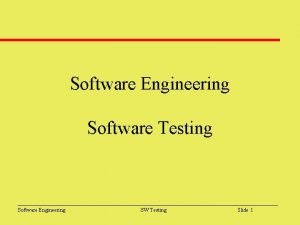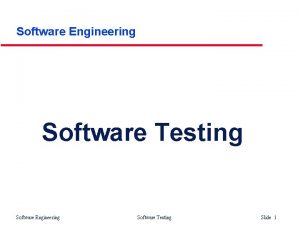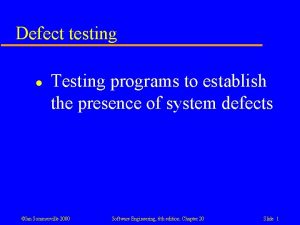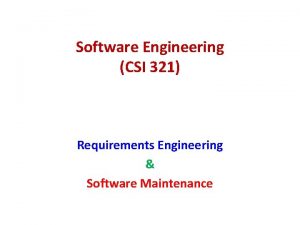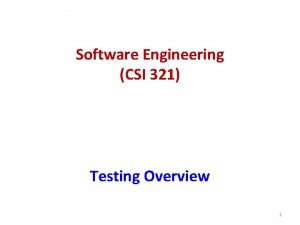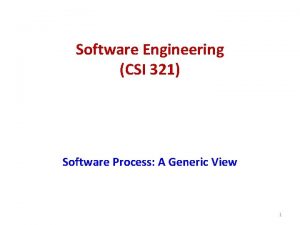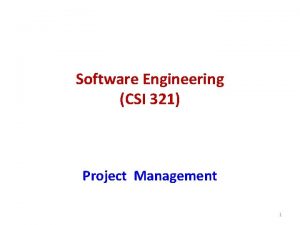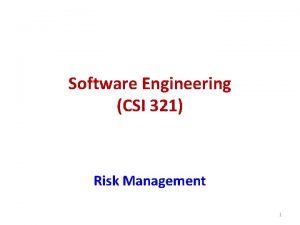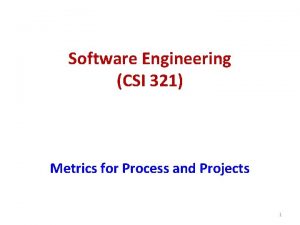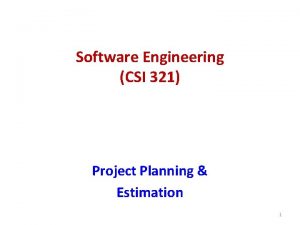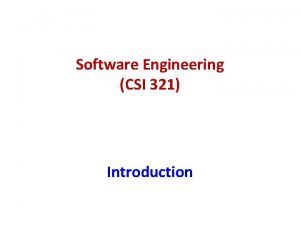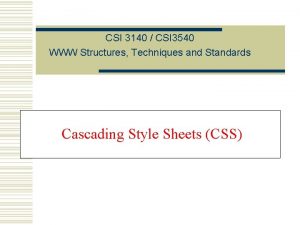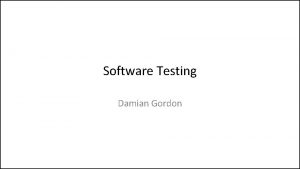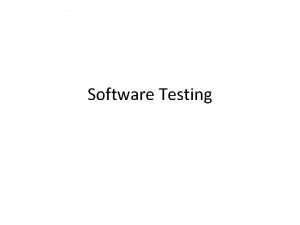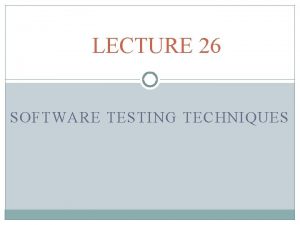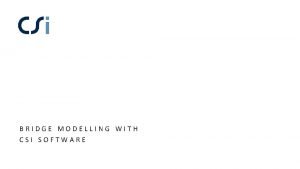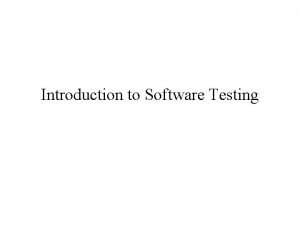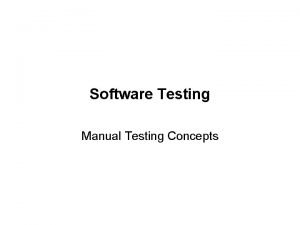Software Engineering CSI 321 Testing techniques 1 Software
























- Slides: 24

Software Engineering (CSI 321) Testing techniques 1

Software Testing • Testing is the process of executing a program with the intent of finding errors. • A good test case is one with a high probability of finding an as-yet undiscovered error. • A successful test is one that discovers an as-yetundiscovered error. 2

Testing Principles • All tests should be traceable to customer requirements. • Tests should be planned long before testing begins. • The Pareto Principle applies to software testing(80% of all errors are in 20% of the code) • Testing should begin “in the small” and progress towards “in the large”. • Exhaustive testing is not possible. • Testing should be conducted by an independent third party if possible. 3

Software Testability Checklist q What are the characteristics of software testability? § Software testability is simply how easily a computer program can be tested 1) Operability – if it works better it can be tested more efficiently 2) Observability – “what you see is what you test” – Source code is accessible – System states and variables are visible or query-able during execution. 3) Controllability – The better we can control the software, the more the testing can be automated and optimized. 4

Software Testability Checklist 4) Decomposability – By controlling the scope of testing, we can more quickly isolate problems and perform smarter retesting. 5) Simplicity –The less there is to test, the more quickly we can test it 6) Stability – The fewer the changes, the fewer the disruptions to testing 7) Understandability – The more information is known, the smarter the testing can be done 5

Attributes of a Good Test § What is a “good” test? • The following are the attributes of a good test – – – A good test has a high probability of finding an error. A good test is not redundant. A good test should be “best of breed”. A good test should not be too simple or too complex. 6

Black-Box Testing & White-Box Testing § Two basic categories of testing techniques – 1) White Box Testing 2) Black Box Testing 7

White Box Testing • • View components as transparent Based on knowledge of the internal logic Done by programmers (usually) AKA: Structural testing, Glass-box testing, Clear-box testing 8

White Box Testing • Knowing the internal workings of a product, tests are performed to check the workings of all possible logic paths • White box testing uses the control structure described as part of the component level design to derive test cases. • Using white box testing methods, the software engineer can derive test cases that: – Guarantee that all independent paths within a module have been exercised at least once. – Exercise all logical decisions on their true and false sides. – Execute all loops at their boundaries and within their operational bounds. – Exercise internal data structures to ensure their validity. 9

Black-Box Testing • View components as opaque • Based on requirements and functionality • Without any knowledge of internal design, code or language. • Structure of the program is not considered. • Test cases are designed based on the requirements or specification of the program or module. • AKA Functional Testing, Behavioral Testing 10

Detailed Test Case Design • A combination of black box and white techniques are applied depending on the phase of testing - generally white box at the unit testing level, black box during acceptance testing, and both during integration and system testing. § • • • Black Box Methods Equivalence partitioning Boundary value analysis Error Guessing § White Box Methods • Basis path testing • Statement Coverage • Branch Coverage • Condition Coverage • Multiple-condition Coverage 11

Basis Path Testing • Basis Path Testing is a white box test case design technique that uses the algorithmic flow of the program to design tests. • Basis path testing helps a tester to compute logical complexity (also called cyclomatic complexity) measure, V(G), of the code. This value of V(G), defines the maximum number of test cases to be designed by identifying basis set of execution paths to ensure that all statements are executed at least once. – Basis Set is the set of tests derived using Basis Path Testing. These are set of test cases derived from the internal structure or specification to ensure that 100% of a specified coverage criterion is achieved. 12

Basis Path Testing • A White-box testing technique first proposed by Tom Mc. Cabe. • Determine the basis set of linearly independent paths (the cardinality of this set is the program cyclomatic complexity). • Prepare test cases that will force the execution of each path in the basis set. 13

BASIS PATH TESTING • Goal: Each statement is executed at least once. • Consider all paths of program execution. For this purpose it is useful to represent a program as graph. Nodes are blocks of code, directed edges are invocations of other code blocks and represent flow of control. Nodes with two exiting rows contain conditional statements. The graph contains initial and terminal nodes. • A path is a sequence of nodes connecting initial and terminal nodes; an independent path is a path introducing at least one new node. 14

BASIS PATH TESTING • The basis path method enables the test case designer to derive a logical complexity measure of a procedural design and use this measure as a guide for defining a basis set of execution paths. • Test cases derived to exercise the basis set are guaranteed to execute every statement in the program at least one time during testing.

BASIS PATH TESTING FLOW GRAPH NOTATION A flow graph depicts logical control flow using the notation shown below: Each structured construct corresponds to a flow graph symbol.

BASIS PATH TESTING • Flow charts and flow graphs correspond to one another. The flow chart depicts the program control structure. The flow graph assumes no compound structures.

BASIS PATH TESTING • Flow charts and flow graphs correspond to one another. • Each circle, called a flow graph node, represents one or more procedural statements. • A sequence of process boxes and a decision diamond can map to a single node. • The arrows of a flow graph, called edges or links, represent flow of control. • An edge must terminate at a node. • Areas bounded by edges are called regions. 18

BASIS PATH TESTING 19

BASIS PATH TESTING Compound Conditions: • Compound Conditions occur when one or more Boolean operators (OR, AND, NOR) is/are present in a conditional statement. • IF a OR b is represented as follows: FIGURE 14. 3

BASIS PATH TESTING • Independent Program Paths: An independent program path is any path through the program that introduces at least one new set of processing statements or a new condition. • When stated in terms of a flow graph, an independent path must move along at least one edge that has not been traversed before the path is defined. • For example, a set of independent paths for the flow graph illustrated in Figure 14. 2 b is: • Path 1: 1 -11 • Path 2: 1 -2 -3 -4 -5 -10 -1 -11 • Path 3: 1 -2 -3 -6 -8 -9 -10 -1 -11 • Path 4: 1 -2 -3 -6 -7 -9 -10 -1 -11

BASIS PATH TESTING • A basis set for a flow graph is the set of paths that cover every statement in the program. • Therefore Paths 1, 2, 3, & 4 are the basis set for the previous figure. • If tests are designed to force execution of these paths, every statement is guaranteed to execute at least one time. Every condition will have been executed on its true and false sides. • Note: A basis set is not unique. A number of basis sets may be derived from a procedural design. • How do we know how many paths to look for?

BASIS PATH TESTING • The number of independent paths can be used to measure the complexity of a program. It is called cyclomatic complexity. • Cyclomatic complexity is an upper bound for a base set of path, i. e. a set of path that includes each node. • If each path is translated into a test case, each statement will be tested at least once. • Cyclomatic complexity is a software metric that provides a quantitative measure of the logical complexity of a program.

What is the significance of the value of V(G)? • Cyclomatic complexity, V(G) is a useful metric for predicting those modules that are likely to be error prone. – Use it for test planning as well as test case design. • Often components with a high V(G) are a high risk for error and should be tested more completely. • In general, V(G) > 10 is not acceptable. 24
 Csi 321
Csi 321 What is project scheduling in software engineering
What is project scheduling in software engineering Practitioner myths in software engineering
Practitioner myths in software engineering Domain testing
Domain testing Motivational overview of logic based testing
Motivational overview of logic based testing Data flow testing strategies in software testing
Data flow testing strategies in software testing Globalization testing
Globalization testing Language testing
Language testing Control structure testing in software testing
Control structure testing in software testing Decision table testing in software testing
Decision table testing in software testing Decision table for triangle problem
Decision table for triangle problem Decision table based testing
Decision table based testing Rigorous testing in software testing
Rigorous testing in software testing Testing blindness in software testing
Testing blindness in software testing Domain example
Domain example Hierarchy of software
Hierarchy of software User testing software engineering
User testing software engineering Types of testing in software engineering
Types of testing in software engineering Sw in software engineering
Sw in software engineering Software testing
Software testing User testing software engineering
User testing software engineering Testing activities in software engineering
Testing activities in software engineering Cluster testing in software engineering
Cluster testing in software engineering What is regression testing in software engineering
What is regression testing in software engineering Basis path testing
Basis path testing
